Last Updated on October 14, 2025 by Ioana
I was born and raised in Romania, and I moved back here in 2024 after living in NYC for almost 14 years. Since I lived in the US and I also traveled to 20+ countries so far, I can objectively tell you that Romania is one of the most underrated European countries. I think it’s the perfect destination and you should visit it before it gets more popular and crowded. In this blog post I will share the best itinerary created by a local (yours truly) to explore Romania in 5 days. This post contains affiliate links. When you make a purchase I may get a small commission at no extra cost to you. Find out more here.
Planning your next trip? Check out these helpful resources:
Bucharest
Bucharest is the capital city and the largest city of Romania. This is where you’ll fly into. My recommendation as a native Romanian is to only spend 1-2 days here.
The most beautiful parts of Romania are outside of Romania. That being said, I think it’s worth checking out a few places in Bucharest.
Palace of Parliament
The Palace of Parliament was built during the communist era at the orders of Nicolae Ceausescu. It is one of the main attractions in Bucharest.
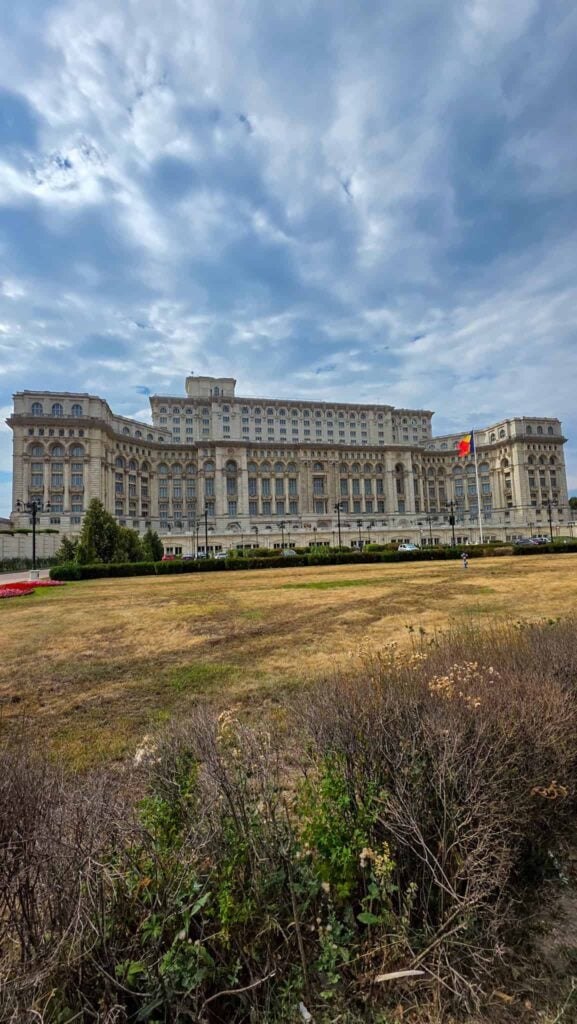
It is the heaviest building in the world, weighing about 4,098,500 tons (9.04 billion pounds), and it’s the second largest administrative building in the world after the Pentagon.
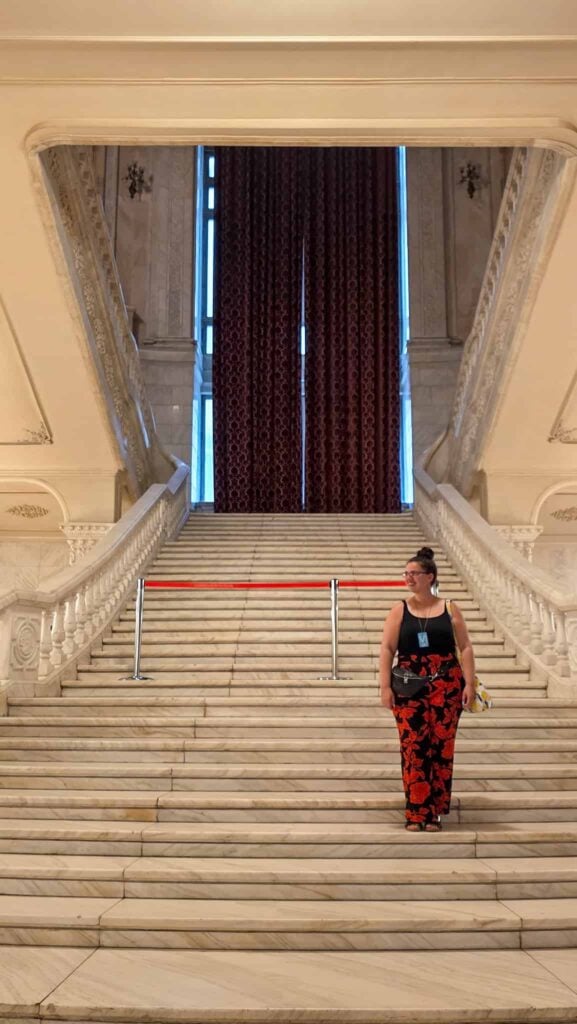
Nowadays the palace houses the Romanian Senate, the Chamber of Deputies, three museums and an international conference center.
The palace was nicknamed the People’s House after the 1989 Revolution that led to the fall of communism.
✈️ Heading to Romania soon? Check out these guides:
Carturesti Carusel Bookstore
Carturesti Carusel is a spectacular bookshop located in the heart of Bucharest. It is the most impressive bookstore in Romania and, in my opinion, one of the most beautiful ones in the world.
The building that hosts the bookstore was built at the beginning of the 20th century and it used to be a bank.
The inside has multiple floors, all having an elegant white design. There are lots of windows and it’s very bright everywhere.
You can browse books, admire the architecture and design, or grab a cup of coffee at the cafe on the top floor.
Cismigiu Park
There are lots of parks in Bucharest, but Cismigiu is my favorite one. I used to spend a lot of time here in high school when I was in Bucharest preparing for the International Chemistry Olympiad.
It is a park that’s in the heart of the city, next to the University of Bucharest.
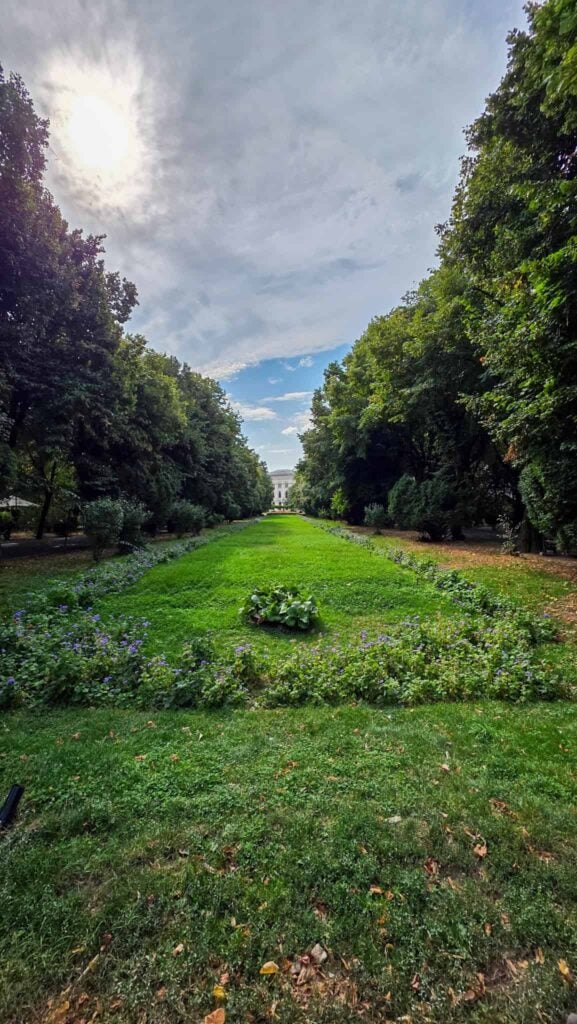
It has a lot of trees, flowers, green spaces, and an artificial lake. There are plenty of benches along the park so you can sit down and take it all in.
It’s the perfect place for people watching, taking a stroll, and relaxing after a day of exploring the city.
The park also has multiple landmarks. One of them is the Writer’s Rotunda, which has stone busts of 12 important Romanian writers.
Bucharest Old Town
Bucharest’s nickname is Little Paris. That’s because it had gorgeous architecture that resembled the one in Paris.
Of course, communism happened, and the grey, depressive buildings started to appear and to reduce the esthetic beauty of the city. But the Old Town still preserves the beauty of pre-communism Bucharest.
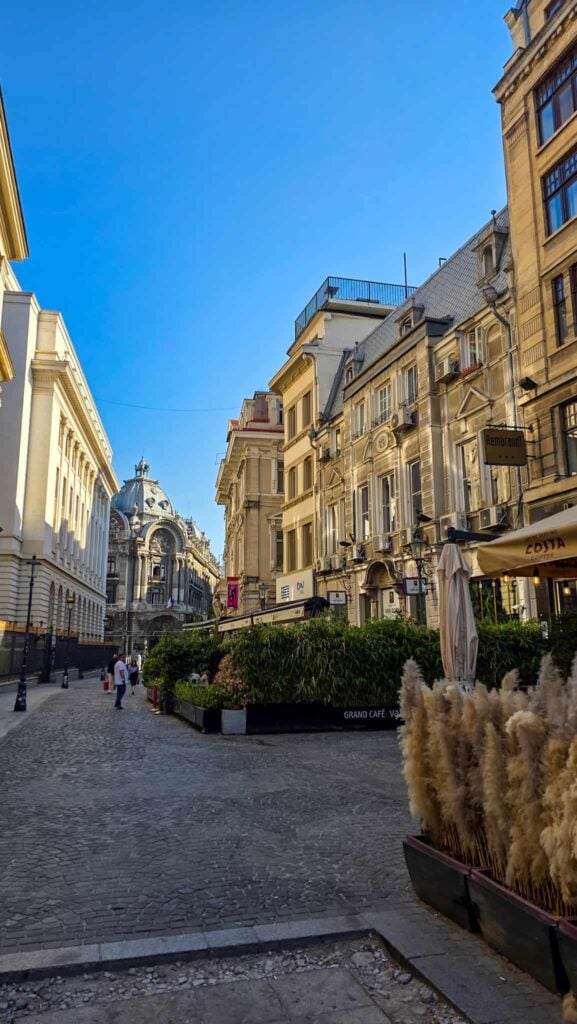
You can find a lot of cafes and restaurants in this area where you can enjoy a traditional Romanian lunch or dinner. You can dine outside if you visit during the summer months.
This area has a lively vibe and the cobblestone streets add to the charm. The nightlife here is elite, so if you like to party, make sure to stop by one of the clubs here.
Stavropoleos Monastery
This monastery was built in 1724 by a Greek monk. He was the owner of an inn in the city center and to thank God for the inn, he decided to build this church. Then he left the inn behind and he became a monk.
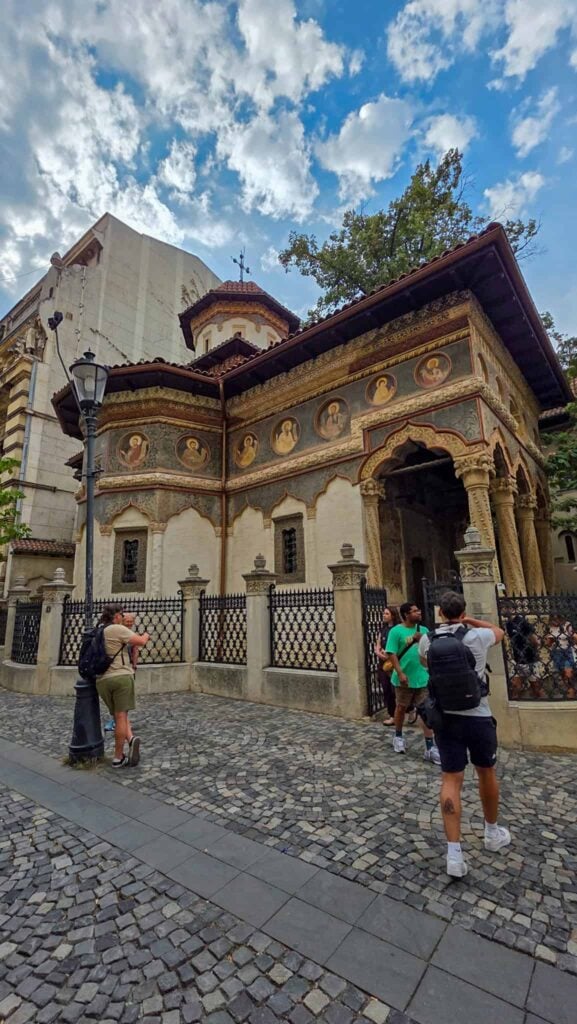
It is a small, but special church that is full of history. It was built in the Brâncovenesc style. The church is still operational and it is well maintained.
It has the largest collection of Byzantine music books in Romania. People from all over the world visit this monastery.
Therme
Therme Bucharest is Europe’s largest wellness center. It has multiple thermal water pools, mineral water pools, saunas, water slides, infrared light beds, and even a botanical garden with 800,000 species of plants.
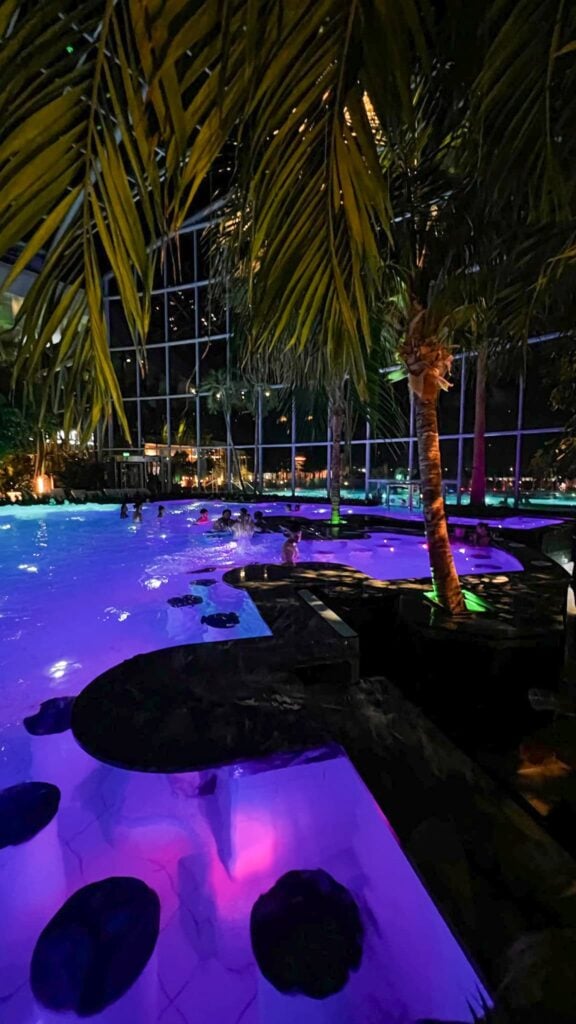
There are plenty of bars and restaurants where you can grab a bite in between swims and massage sessions.
Therme is the best place to relax while in the capital of Romania.
Eat at Caru’ cu Bere
Caru’ cu Bere is one of the best restaurants in Bucharest that serve traditional Romanian food. The restaurant is located in the Old Town and it has a beautiful decor with wood panels and stained glass windows.
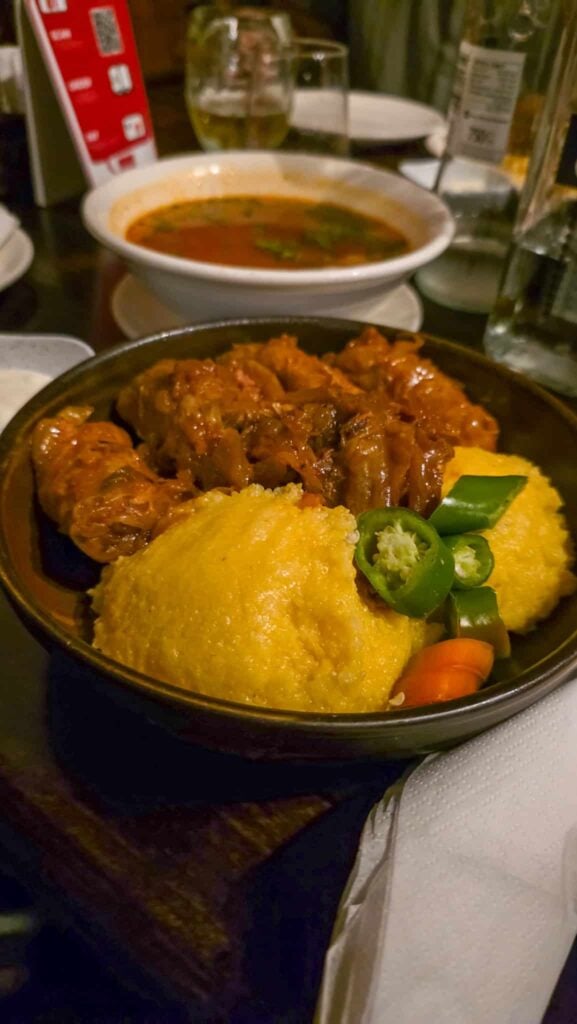
It has been operating for about 130 years in the same location. They have live music and dances both during lunch and dinner.
Stopping by Caru’ cu Bere is a must when you’re in Bucharest. They are open every day from 9am to midnight. Make sure you make a reservation since it’s a very popular spot.
Brasov
Brasov is a city in the Transylvania region. It is one of the major cities in Romania tucked away in the Carpathian Mountains.
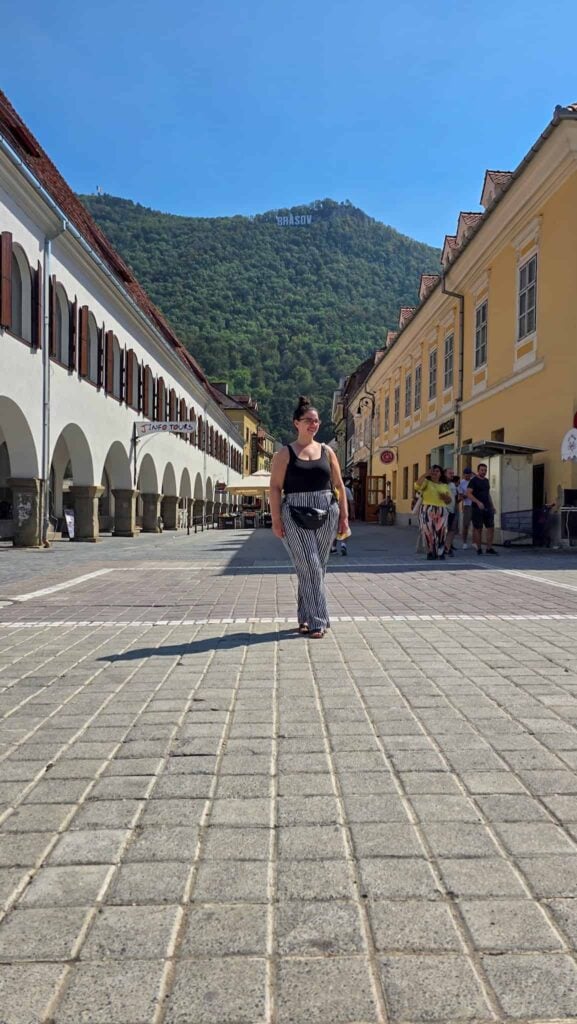
Back in the 13th century the city was occupied by German settlers, the Transylvania Saxons. Then in the 15th century by Turks, in the 17th century by Austrians, and until 1918 by Hungarians.
Brasov has a rich history and it is one of the most beautiful cities of Romania. It’s also close to Dracula’s Castle and Peles Castle, so it’s worth stopping by for a few days.
Check out this guide on where to stay in Brasov.
Black Church
The Black Church was built in the 14th century by the Saxons. It is a gothic church and it is the main gothic-style monument in Romania.
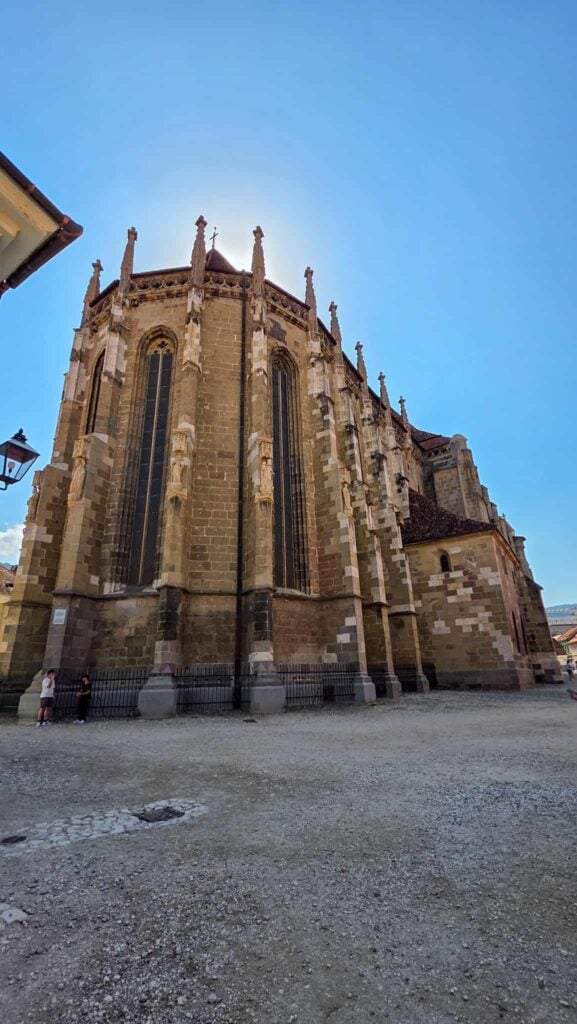
It is a church that still operates today and it is also a tourist attraction that can be visited.
Council Square
Piata Sfatului, or Council Square, is the main square in Brasov. It’s located in the city center and this is where you can find the Black Church as well.
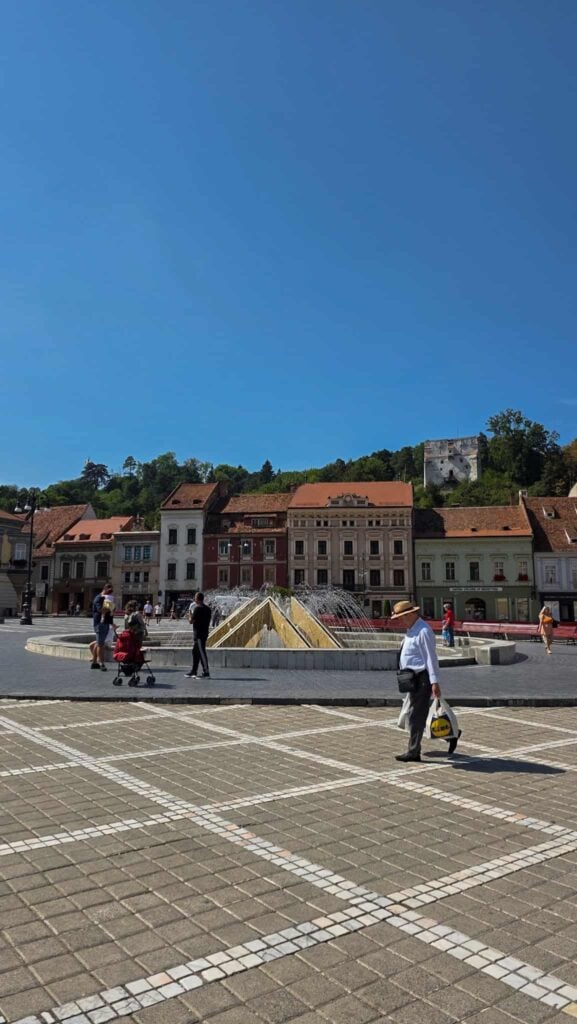
This has been the place where merchants from all over the country and from abroad would sell their products since 1364.
There are 18th and 19th century houses in the square, most of which are historical monuments.
Hike to the Brasov sign
There is a sign that says Brasov on Mount Tampa. It’s similar to the Hollywood sign in LA, except it’s on a mountain.
The distance between the city and the sign on Mount Tampa is 2.7km and it usually takes about an hour to get there.
The hike has a scenic route and you will get the best view of Brasov once you get to the top.
Rope Street
Rope Street is the narrowest street in Romania. It is believed to be one of the narrowest streets in Europe. Only L’Androuno in France, Spreuerhofstraße in Germany, and Parliament Street in England, are narrower than Rope Street.
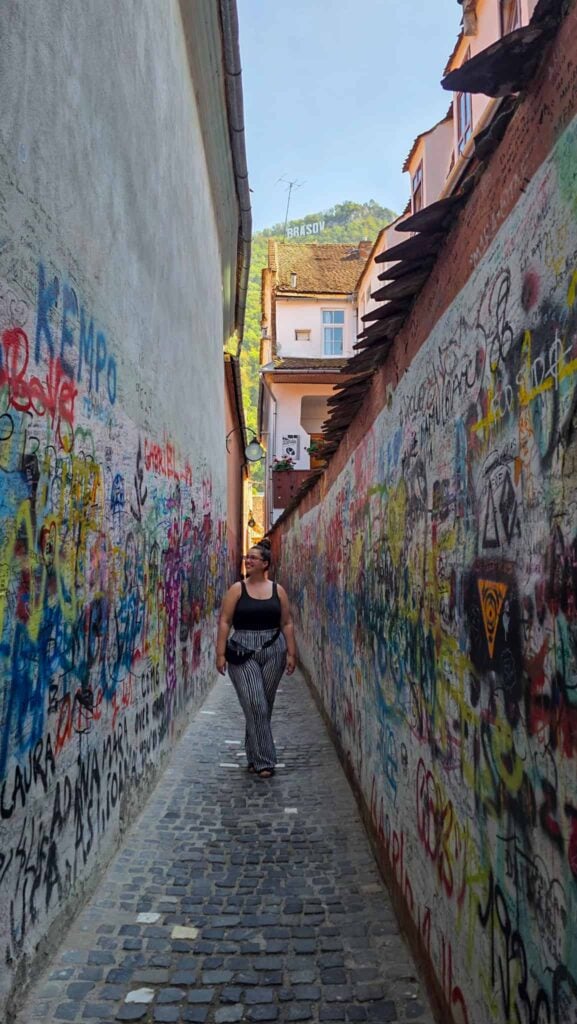
It’s really cool to walk on this street. I think you should definitely add this spot to your Romania itinerary.
✈️ Heading to Romania soon? Check out these guides:
Bear watching
Romania is home to more than half of Europe’s Brown Bear population. And they all live in the Carpathian Mountains.
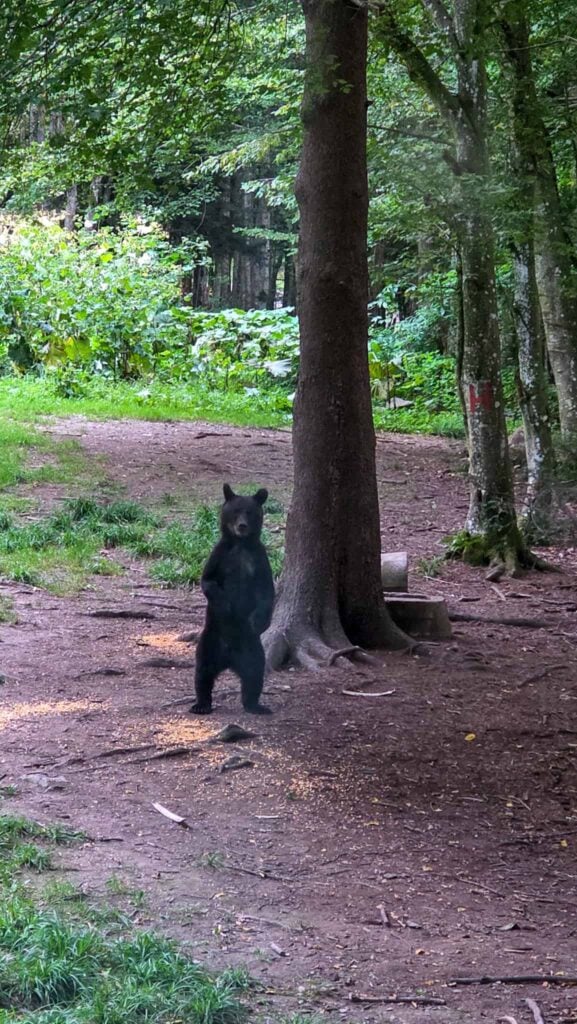
During a bear watching tour you will go to a bear hide deep into the woods with a local guide. All tours take place in the afternoon.
The hide is a facility where wild brown bears are attracted with food for close-up observations. The tour is safe as everyone will be indoors in an observatory.
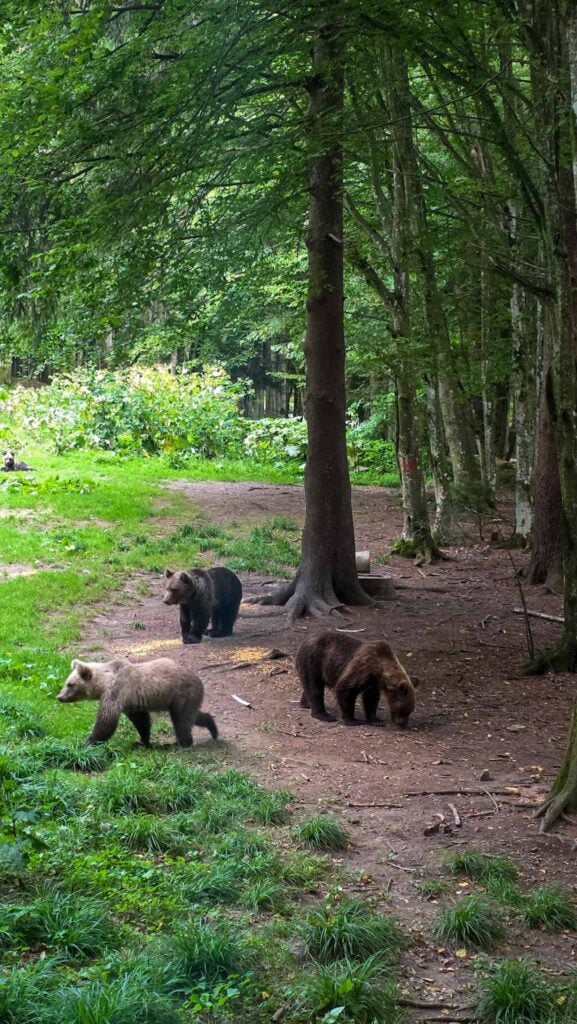
These observatories were designed by wildlife photographers for wildlife photography, so they are great spots to watch the bears and take some amazing pictures.
If it’s your first time in Romania you should absolutely do this activity.
Bran Castle (Dracula’s Castle)
When people think of Romania the majority think of the myth of Dracula. Thanks, Bram Stoker!
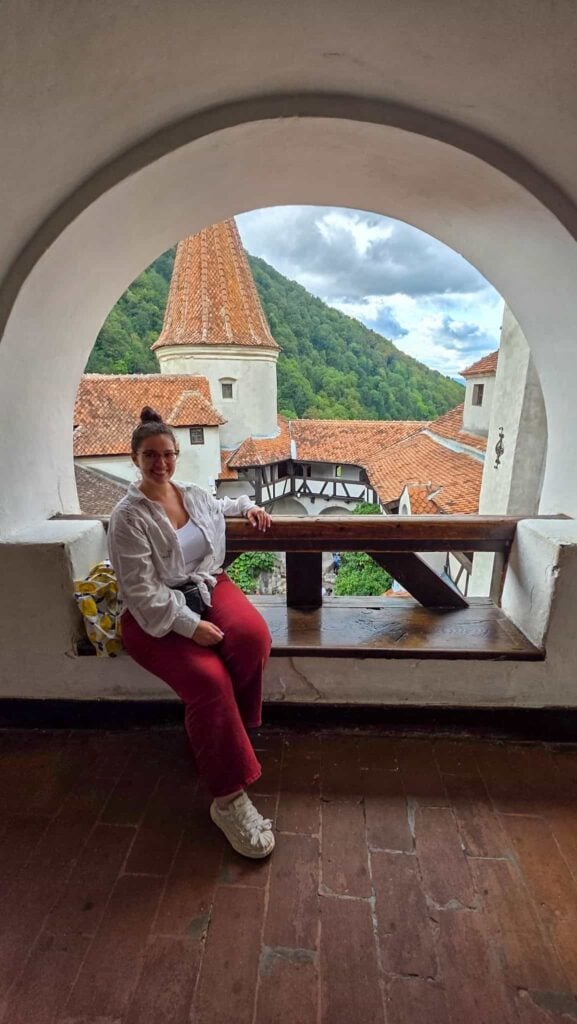
While the vampire is fictional, it was inspired by Vlad Dracul or Vlad Tepes. He was the Voivode of Wallachia (now Romania) in the 1400’s, a very cruel leader who used to impale his enemies.
Bran Castle is supposedly the castle where Count Dracula used to live in Bram Stoker’s book. It is actually a castle built in the 14th century by the Transylvanian Saxons.
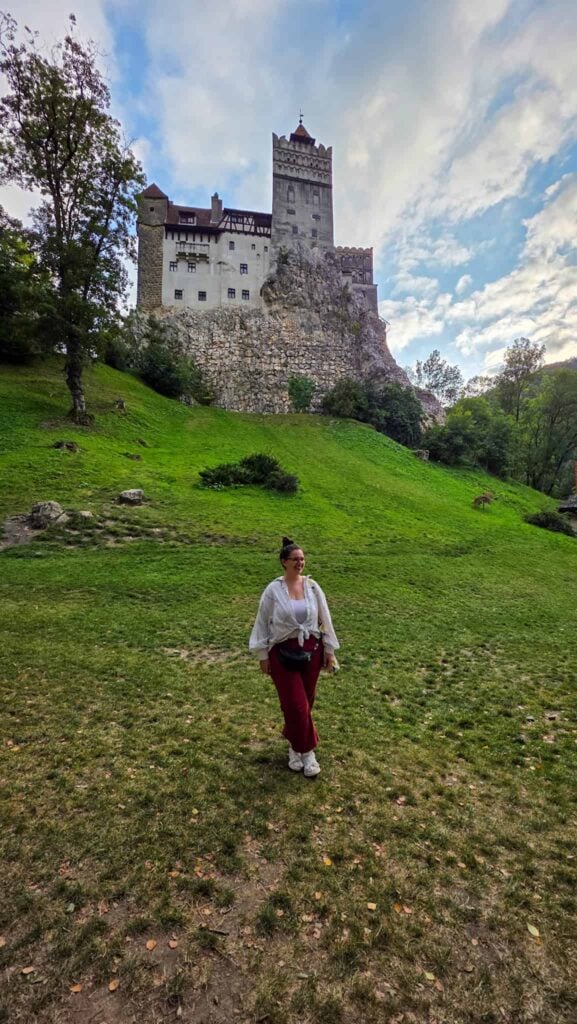
Vlad Tepes does not seem to have had a significant role in the history of this castle. Regardless, it is a cool medieval castle and it’s worth visiting. The folks working there always make sure that visitors get an amazing Dracula experience.
Peles Castle
Peles Castle is one of the most beautiful castles in Romania. I believe that it’s more beautiful than Bran Castle.
It is a Neo-Renaissance palace in Sinaia, a mountain town in the Carpathian Mountains, close to Brasov.
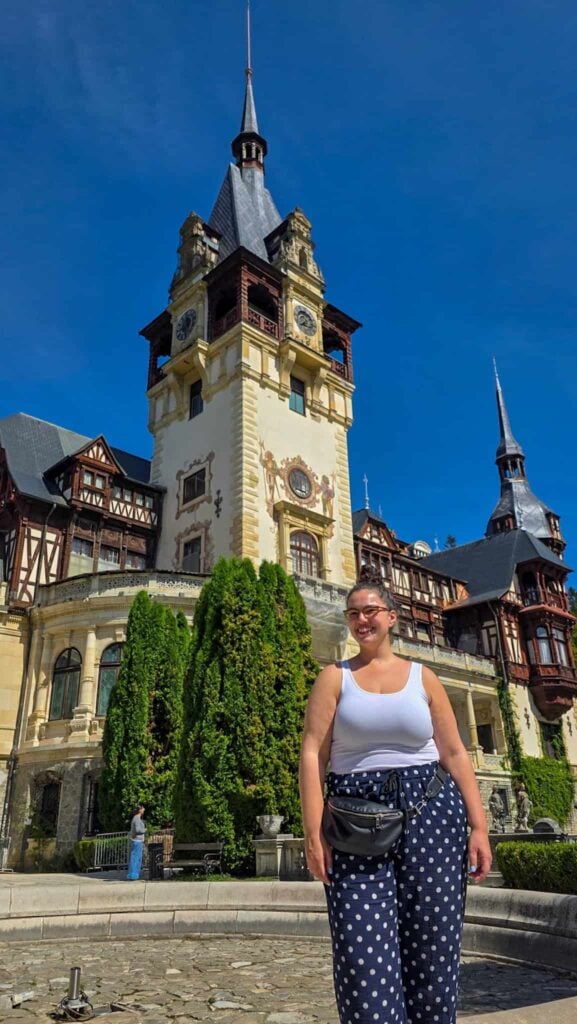
The construction of this palace started in 1873. Apparently when King Carol I of Romania, under whose reign the country gained its independence, first visited the site, he fell in love with the impressive mountain scenery. I don’t blame him. I fell in love with it too.
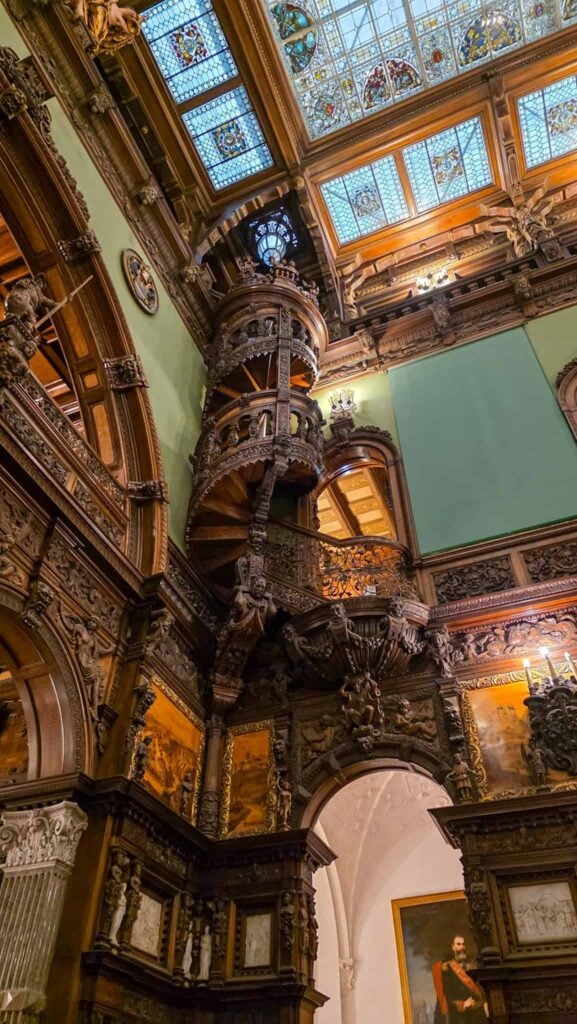
He commissioned the construction of a summer estate and a hunting lodge. That’s why the Peles complex consists of 3 buildings: Peles Castle, Pelisor Castle, and the Foisor Hunting Lodge.
You should not skip this place while in Romania.
Sighisoara
Sighisoara is a well-preserved medieval town that is also a UNESCO World Heritage Site.
In the 12th century the German Saxons came to this area to defend the frontier of the realm and develop the economy.
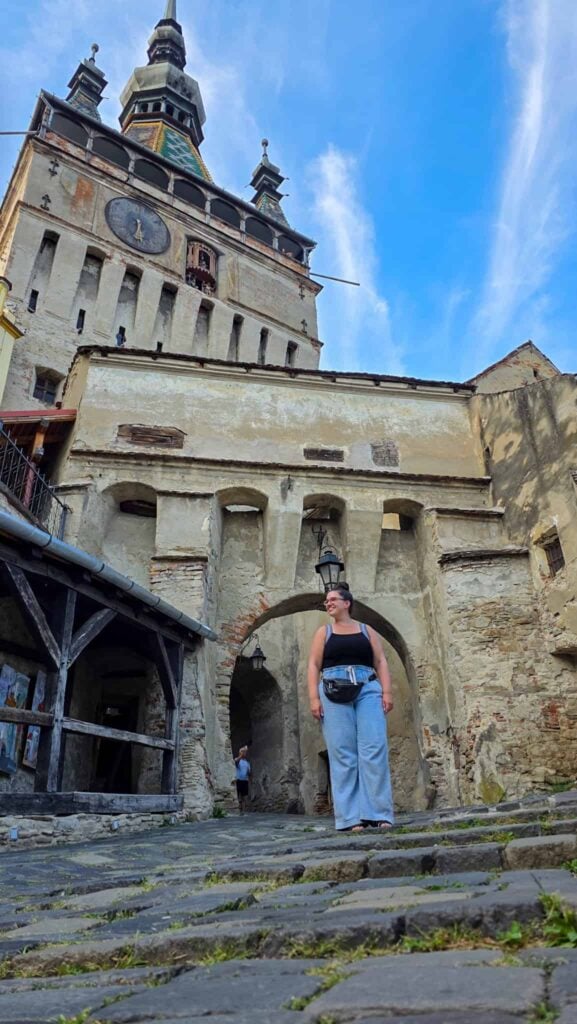
They did a great job as Sighișoara became one of the most important urban centers in Transylvania. Merchants and artisans from the Roman Empire used to come here.
Sighisoara is also the birthplace of Vlad Tepes (Dracula) and you can visit the house where he was born.
During the 14th and 15th centuries 14 towers were built in Sighisoara as a defense system. The most striking one is the Clock Tower.
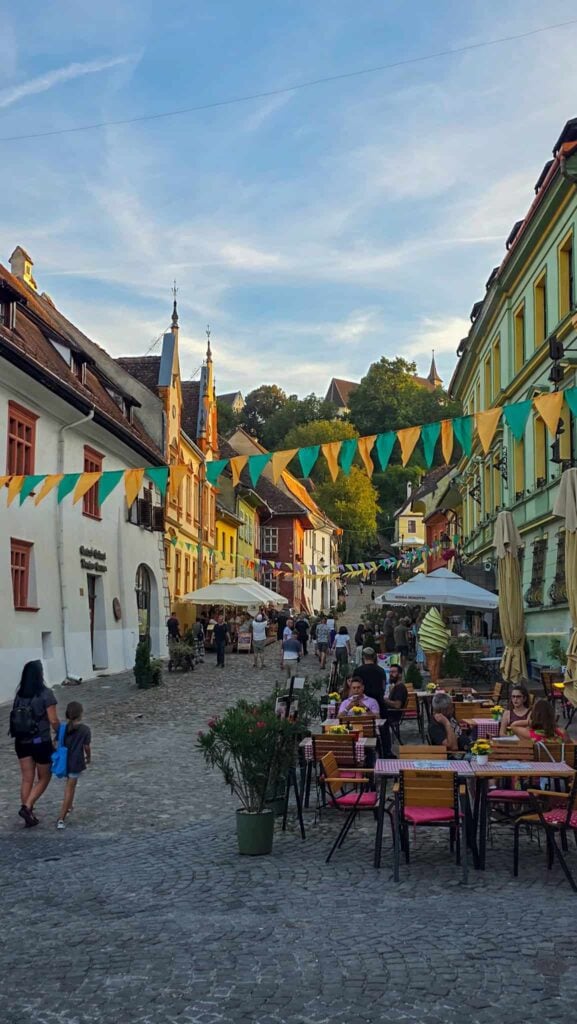
Visiting this tower, getting lost on the cobblestone streets and admiring the colored buildings will make you feel like you stepped back in time.
Sighisoara is my favorite town in Romania. It rivals more well-known medieval towns in Western Europe. You should definitely visit it.
Turda Salt Mine
Salina Turda is a salt mine in Transylvania, near Cluj. It is one of the most spectacular destinations in the world. It’s an underground formation that people created by digging into the salt deposited after the evaporation of the sea that covered the entire region millions of years ago.
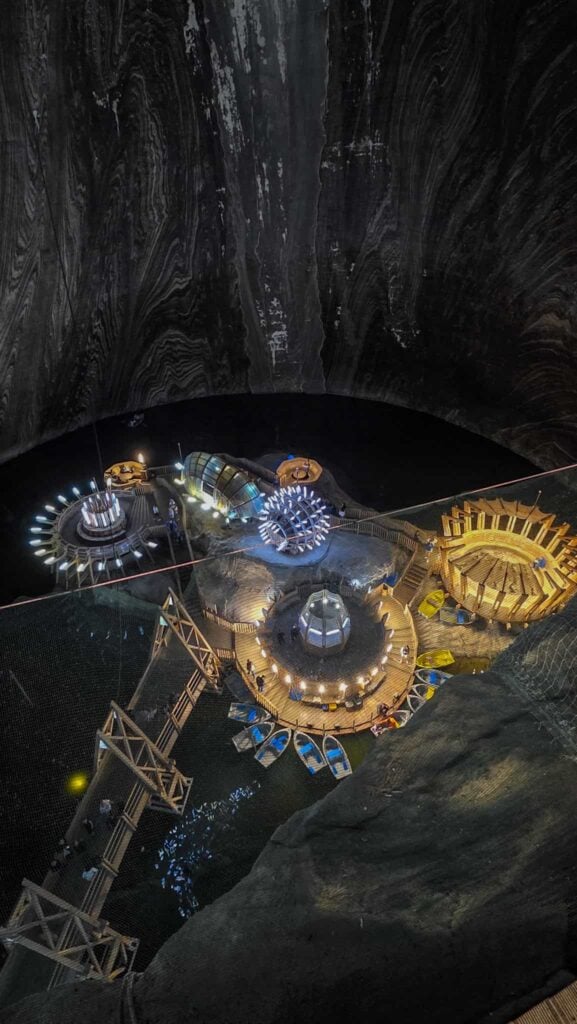
In 2008 the salt mine was modernized and it now includes a whole world 120 meters underground. It offers incredible attractions: a Ferris Wheel, bowling, rowing a boat on the Salt Lake, ping pong, golf, tennis. It is one of the most impressive salt mines in the world.
It’s also a popular place for halotherapy (salt therapy) as people believe that breathing in the salt air helps with sinus and respiratory tract medical problems.
Fun fact: the salt in Salina Turda could cover the salt requirement for the entire planet for 60 years.
Immerse yourself in the local culture and traditions
If you want to go off-the-beaten path you can add a few cultural activities to your itinerary. For example, you can visit a gypsy community to learn how they live.
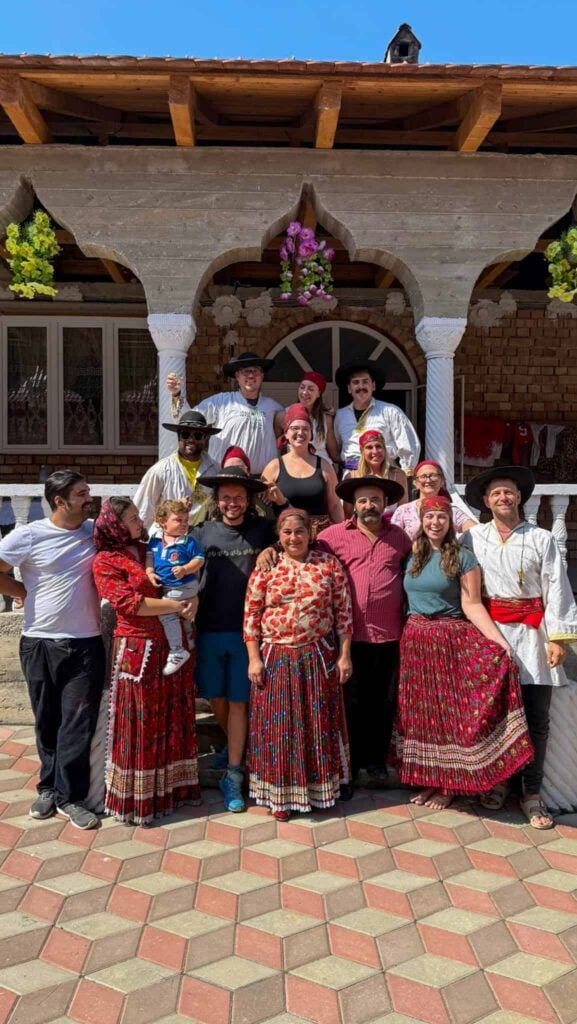
You can visit a sheepfold to see how this old way of taking care of sheep stays alive in Romania (and taste some amazing cheese).
Or you can go to a cooking workshop in a Romanian village to learn how to make some delicious traditional Romanian dishes such as sarmale.
Drive on Transfagarasan
Transfagarasan is the most beautiful road in Romania and one of the most impressive roads in the world. It is a road that goes through the Carpathian Mountains, so the scenery is unmatched.
It was built during the Ceausescu era to ensure Romania had quick military access across the mountains in case of a Soviet invasion.
The road is partially closed during the cold months. But you can drive its entire length if you visit during the summer.
Transfagarasan provides access to Balea Lake, a glacier lake. If you visit when Transfagarasan is closed you can take a cable car to get to Balea Lake.
There is also an ice hotel that is built every year near Balea Lake. You can experience spending a night in an ice hotel at a fraction of the cost you would pay in Finland, for example. And it’s equally as beautiful, except you won’t be able to see the Northern Lights in Romania.
If you have an extra day, explore the Danube Delta
The Danube Delta is such an underrated attraction in Europe. The delta occurs where the Danube River meets the Black Sea in Romania.
The Danube Delta has one of the most unique floras and faunas in Europe, with numerous rare species. The area is a UNESCO World Heritage Site.
In the Letea Forest in the delta you can find wild horses. This is one of the most unique things in Europe and the world. The entire Danube Delta is a paradise for nature lovers and photography enthusiasts.
✈️ Heading to Romania soon? Check out these guides:
FAQs about Romania
I highly encourage you to read this article I wrote about stereotypes about Romania and what my honest opinion is of them. It will help you understand our history and learn how things evolved and how the country developed over the last 35 years.
Best time to visit Romania
You can visit anytime. It depends on what you want to do.
If you visit in the spring or summer you can enjoy warmer weather and you can spend a lot of time outdoors and explore. Romania tends to be sunny during the months of May – September.
The temperatures are between 20 – 30 degrees Celsius (maybe a bit more during July and August as we had some heat waves in recent years). It’s not a humid country, so it’s easier to tolerate the heat.
Transfagarasan is fully open during the summer, so if you want to tick off this bucket list item make sure you visit June – September. The road is partially closed during the colder months.
If you visit during the fall it will be a bit colder, but the leaves are changing colors and you can experience that beauty as you go on your road trip through Romania. The Romanian countryside is magical during this time of the year.
If you visit during the winter it will be cold. But you can add skiing and snowboarding to your itinerary. We have plenty of ski resorts in the Carpathian Mountains.
There is also an ice hotel that is built every year near Balea Lake. You can experience spending a night in an ice hotel at a fraction of the cost you would pay in Finland, for example. And it’s equally as beautiful, except you won’t be able to see the Northern Lights in Romania.
How can I get to Bucharest city center from Henri Coanda International Airport?
Bus
If you’re a fan of public transportation, you can take Bus Line 100. It has stops everywhere in Bucharest city center: Piata Unirii, Piata Romana, Piata Victoriei, Universitate. This bus runs every 15 minutes during the day and every 30 minutes during the night.
You can pay by card on board (a one way trip costs less than a euro). The bus station is outside of the Arrivals terminal. Just follow the signs when you get out of the airport.
Taxi / Uber / Bolt
This is the most convenient option since it leaves you right in front of your hotel. Uber and Bolt both operate in Romania, so if you’re coming from Europe or the US you can use the same apps to get a car in Romania as well.
Alternatively you can also schedule a private transfer.
How to get cell phone data when visiting from abroad?
The cheapest and most convenient way to get data while visiting from abroad is to buy an eSIM. An eSIM is a digital SIM that lets you activate a data plan from a provider without having to use a physical SIM card. They are super easy to use.
I use Airalo. You can go to their website, select the country you’re traveling to, select how many GB of data you want, and how many days you want the eSIM to be active for. After you pay you will receive a confirmation email with instructions on how to activate the eSIM.
You can activate it on your phone and the process takes under 1 minute. Once the eSIM is activated you don’t have to do anything else. When you’re at your destination you will automatically get data.
Is Romania safe for a solo female traveler?
Yes, Romania is safe for solo female travelers. This is probably the number one question I’m being asked about Romania, so let me give you the full answer here.
One of the stereotypes about Romania is that it’s not a safe country. A lot of people still avoid visiting because of this.
This was true in the first 10-20 years after the fall of communism (1989 – 2009).
After the 1989 Revolution everyone was trying to make money and stop living in scarcity. And because there was so much corruption and no systems put in place to help people, some people had to resort to scamming and stealing.
Back in the day pickpockets would steal money from you at the airport, on the street, literally anywhere. There is even a song by Romanian rapper Puya saying something like “when you land in Romania, make sure to keep your money close to you”.
Taxi drivers used to scam tourists as well. They would always ask for more money than what the price actually was.
But things have evolved so much and are so different now. We are part of the EU and Schengen. The country developed tremendously and the economy has been growing consistently.
So these things don’t happen anymore because people don’t need to resort to scamming and stealing to live a decent life. That’s why debunking myths about Romania is so important.
I live in Romania again after being in NYC for 14 years and traveling all over Western Europe and I feel safer in Romania than I felt in Western Europe or the US.
What is the currency in Romania?
While Romania has been part of the European Union since 2007, it is not in the Eurozone yet. Our currency is lei. 1 euro (or 1 dollar) = 5 lei.
Do I need cash for my trip to Romania?
Yes, you do. While you can pay with a credit card in every city in Romania, places in the countryside or smaller mom-and-pop businesses are still cash-only.
So if you want to eat at a traditional local eatery that’s not in the city, or if you want to buy souvenirs or tip your tour guides make sure you have cash.
Pro tip: always get cash from an ATM in the airport instead of going to an exchange place. Your bank will always have better exchange rates when taking out cash in a foreign currency from an ATM.
Do I have to tip in Romania?
Tipping is not mandatory, but it is highly encouraged. I usually leave 5-10 lei (the equivalent of 1-2 euros) as tip when I eat out. They highly appreciate it when you do this.
Do I need to book tickets for attractions in advance?
You can book tickets online in advance of your trip if you want to have peace of mind, especially for activities that have limited spots and can sell out, like bear watching.
You can buy entry tickets to castles and other attractions from the ticket office on the day you visit. The chance of them being completely sold out is very small.
What language do people speak in Romania?
The official language in Romania is Romanian. Contrary to popular belief, Romanian sounds nothing like Russian.
Romanian is a romance language. That means that it has Latin roots, and it is very similar to Spanish, French, Italian, Portuguese and Catalan. For example, the word “good” is “bun” in Romanian, “bueno” in Spanish, “buon” in Italian, and “bon” in French. Do you see the resemblance?
Romanian has some Slavic influences, so there will be words that don’t sound anything like their Spanish or French counterparts. One example is the word for “snow”, “zăpadă”. This is a Slavic word, and it is quite different from “nieve” in Spanish or “neige” in French.
However, overall, Romanian is very similar to its romance language cousins, and it sounds nothing like Russian.
Do people speak English in Romania?
Yes, they do. Pretty much everyone speaks English in Romania nowadays, especially the younger folks.
Most people also speak a little Spanish because Latin-American soap operas were very popular in Romania at the beginning of the 2000’s. And since Romanian is similar to Spanish we all picked up Spanish.
That’s how I learned Spanish. And I am also able to understand bits and pieces of all other romance languages.
What Romanian words should I learn before my trip?
- Buna (pronounced boo – nuh) = hello
- La revedere = goodbye
- Multumesc = thank you. But you can also say merci (the short form of multumesc, pronounced exactly like the French word).
- Da= yes
- Nu = no
- Card = credit card
✈️ Heading to Romania soon? Check out these guides:
Need inspiration for your next trip? Check out some of my other articles.
Paris solo travel: everything you need to know
Andorra itinerary: everything you need to visit
Warsaw itinerary: ultimate guide for your first visit
Barcelona 3 day itinerary: the best things to do
Doha itinerary: the best guide for your first visit
Tallinn in 2 days: everything you need to know
Beginner’s guide to NYC: everything you need to know
The best guide for solo travel to Amsterdam
Solo female travel to London: the ultimate guide
The best Oradea 3 day itinerary: a native’s top picks
Istanbul solo travel guide: is Istanbul safe for women?
Helsinki in 2 days: everything you need to visit
Solo travel in Vienna: how to have the best trip
Florence 4 day itinerary: the best guide for solo travelers
Athens 4 day itinerary: ultimate guide for your first visit
4 Day Dublin itinerary: everything you need to know
Solo travel in Milan: the best things to do
Solo travel to Toronto: the ultimate 2 day itinerary

Ioana was born and raised in Romania, lived in NYC for 14 years, and has since returned to Romania. She began traveling solo at 30 and has now visited 25+ countries. Ioana is a full time travel blogger and content creator. Her blog gets 100K+ views per month and her Instagram community has 80K+ people. She loves to share practical travel tips, itineraries, and recommendations for fellow travelers. Her story and insights have been featured in The Daily Express, Euronews, Bored Panda, Yahoo, MSN and more.
